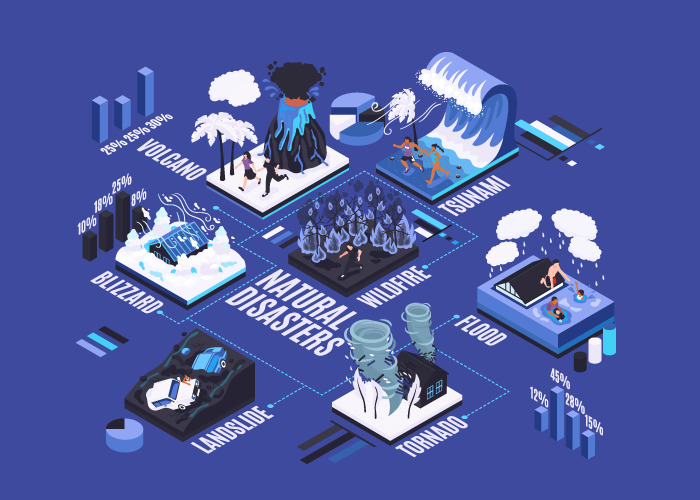AI and Climate Change

Climate change has been a significant threat to existing life for well over decades. In the last 6 years alone, the number of natural disasters has tripled from what they were in the 1980s. Currently, 20 percent of species face extinction. This number is expected to rise to 50 percent in the next eight decades. Certain schools of thought maintain that even if all the countries keep to the Paris Agreement, temperatures will continue to rise. Considering the current state of affairs, with a pandemic ravaging our society, even with reduced stress on our environment, our carbon emissions haven’t slowed to an acceptable degree. This leads to the postulation that a robust solution is required to ensure our survival into the next century. In such a dire situation, Artificial Intelligence(AI) can help curb climate change to an extent.
AI in action
Addressing climate change requires the formulation and implementation of a robust mitigation system that will not only analyze data but derive action plans from the available information. This is where AI can be used to great effect.
Given below is a list of crucial areas in which the use of AI can not only expedite the process of climate change control but also draw informed projections concerning the climate.
Electricity Systems
Electricity has been the driving factor for modernization and our world is dependent on it. The electrical energy supplied to consumers comes from a power grid. This grid either utilizes greenhouse gas-producing fossil fuel or uses low carbon production techniques.
About generators that are reliant on fossil fuels, a significant loss of electricity occurs during transmission as heat. This in turn drives up the use of fossil fuels to meet the demand. Even though most of this loss of electricity is unavoidable, machine learning can be utilized in suggesting grid upgrades and in the maintenance of the transmission systems. This will help in the reduction of the use of fossil fuels and prevent electricity loss to a certain extent.
For low carbon-based electricity generating methods like windmills and solar panels, their efficiency is related to external factors. These factors being – wind speed, current climate, current demand, etc. This creates either a deficit in energy supply or a surplus, creating a need for fossil fuel-reliant generators to be used to cover the deficit, and storage systems absorb the surplus. Through the employment of robust deep learning systems climate patterns, energy requirements, maintenance needs can be studied. This will help in making accurate projections in the aforementioned areas. Thus reducing energy loss, dependency on greenhouse producing energy generators which will directly impact our carbon emissions. The employment of ML in the energy industry can help in taking significant steps toward suitability and eco-friendly development.
Transportation
Travel and transport form a network essential to our society. This network alone contributes to a quarter of our carbon emissions and has seen every significant technology gain that would help reduce carbon footprints. Here a robust ML system can be employed to study routing patterns and travel habits of trucks, freights, public transportation, and shared rides can help reduce trips. Thus, reducing needless travel and expenditure of GHG emitting fuel and increasing efficiency.
Alternatively, research in better energy storage systems, effective and clean fuel for transportation can be made easier through the use of a neural network AI presenting solutions that a human brain could overlook.
Construction and planning
Buildings and the aggregation of structures to form a community proves to be a significant contributor to greenhouse gases and needless energy loss. Deep learning can be employed to study schematics of buildings to develop better building structures that reduce or eliminate emissions during its building and later in its operations. It can be used to study the energy needs of tenants, temperature, and climate to derive an autonomous system that reduces the needless use of alliances for cooling, heating, lighting, etc.
Such a concept when extrapolated from a single building to a community, AI can be used to make a city almost independent of carbon emissions and achieve sustainability that our previous designs lacked.
Promotion of AI by industries
For sustainable growth and development, major companies are pledging to eliminate their carbon footprint. Here are some such examples of initiatives launched by companies
- Google is currently using its deepMind AI to learn about user patterns and upsurge to optimize its energy consumption in its servers.
- Facebook has entered into a partnership with Carnegie Mellon University, in using AI to find new Electrocatalysts. These substances can be used to convert energy into fuels that are easier to store.
- Microsoft’s, ‘AI for earth’ program has committed 50 million dollars for the development and investigation of potential uses of artificial intelligence in achieving sustainability.
- IBM’s green horizon project in China is using AI to forecast pollution, track pollution sources, and produce strategies to deal with it.
The challenge of climate change can be viewed as an opportunity to improve technology and AI systems. It is no secret that there is a substantial gap between innovation and need. Therefore, the current technology needs to be adequately developed. Here, it wouldn’t be out of place to suggest that the enhancement of deep learning technology and their privacy is an essential part of achieving our goal of sustainable growth. An AI software that can be hacked and manipulated will create dire issues in its working and intended use. Thus, the development of computer science and its security is a necessity.
Finally, Given the promise of AI systems in furthering our goal of eco-friendly development it is required that we create a secure data sharing space and begin investing in the development of the same.
